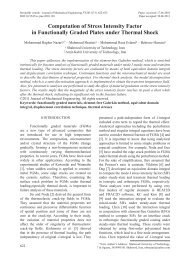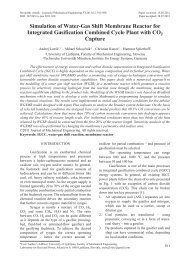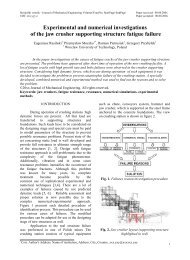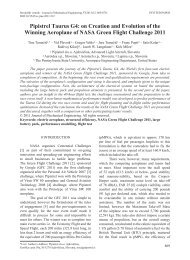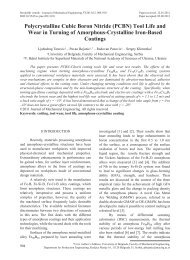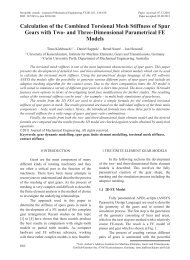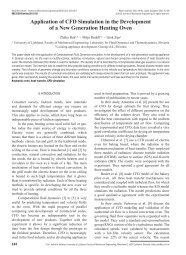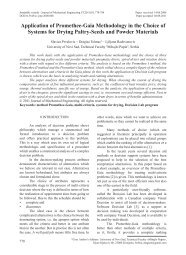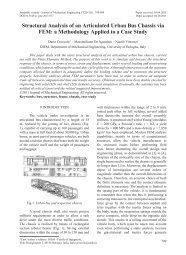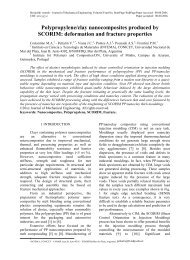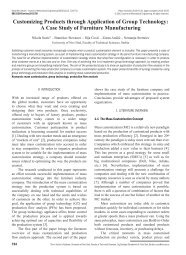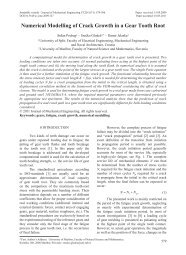Probabilistic Thermal and Electromagnetic Analyses of Subsea ...
Probabilistic Thermal and Electromagnetic Analyses of Subsea ...
Probabilistic Thermal and Electromagnetic Analyses of Subsea ...
Create successful ePaper yourself
Turn your PDF publications into a flip-book with our unique Google optimized e-Paper software.
Strojniški vestnik - Journal <strong>of</strong> Mechanical Engineering 58(2012)11, 665-672Table 1. Statistical characteristic <strong>of</strong> material properties <strong>and</strong> dimensionsProperty Description Unit Mean COV Distributionk 316 <strong>Thermal</strong> conductivity <strong>of</strong> 316L stainless steel W/(mK) 15 0.06 Gaussk 440 <strong>Thermal</strong> conductivity <strong>of</strong> 440C stainless steel W/(mK) 24.2 0.06 Gaussk oil <strong>Thermal</strong> conductivity <strong>of</strong> conduction oil W/(mK) 0.111 0.02 Gaussh sea Convection heat transfer coefficient <strong>of</strong> seawater W/(m 2 K) 200 0.01 Gaussμ 440 Relative permeability <strong>of</strong> 440C stainless steel – 10000 0.05 GaussR pl Radius <strong>of</strong> plunger (see Fig. 2) m 0.0063 0.004 GaussR psi Inside radius <strong>of</strong> plunger sleeve (see Fig. 2) m 0.0065 0.003 GaussR pso Outside radius <strong>of</strong> plunger sleeve (see Fig. 2) m 0.0080 0.003 GaussR mr Radius <strong>of</strong> magnetic ring (see Fig. 2) m 0.0155 0.002 GaussU Applied voltage V 16 0.010 Gauss<strong>of</strong> variables are expressed as the product <strong>of</strong> meanvalves <strong>and</strong> Coefficient <strong>of</strong> Variations (COV).For both <strong>of</strong> the probabilistic thermal <strong>and</strong>electromagnetic analyses, the Latin HypercubeSampling was selected for MCS due to the fact thatthis technique avoids repeating samples that have beenevaluated, <strong>and</strong> also forces the tails <strong>of</strong> a distributionto participate in the sampling process. The centralcomposite design was used to locate the samplingpoints in the design space for RSM.2 EXPERIMENTSIn order to verify the finite element analysis results,the temperature within the subsea solenoid valve<strong>and</strong> electromagnetic force as a function <strong>of</strong> air gapwere measured. Four resistance thermometer sensors(ZYWRNK-191, ZhongYiHuaShi, China) were fixedin Point A, B, C <strong>and</strong> D when the coil was wound <strong>and</strong>the valve was installed, as shown in Fig. 2. The steadystate temperatures in the four points were measuredwhen the solenoid was energized by applied DCvoltage <strong>of</strong> 16 V in the constant temperature bath <strong>of</strong>10 °C.A static experiment was performed to measurethe relationship between the electromagnetic force<strong>and</strong> the air gap. The applied DC power was alsosupplied by a switching power supply (RXN-3020D),which is set to 16 V. The displacement <strong>of</strong> the plungerwas determined by an eddy current displacementsensor (JX70-04-B-M16*1-75-03K), <strong>and</strong> the forcewas measure by an S-shape force sensor (PST-20).By recoding the voltage outputs <strong>of</strong> the force sensor<strong>and</strong> eddy current sensor, the relationship between themagnetic force <strong>and</strong> the air gap could be calculated.a) b) c)Fig. 4. Distributions <strong>of</strong> a) temperature, b) magnetic flux line, <strong>and</strong> c) magnetic flux density668 Cai, B. – Liu, Y. – Ren, C. – Abulimiti, A. – Tian, X. – Zhang, Y.



